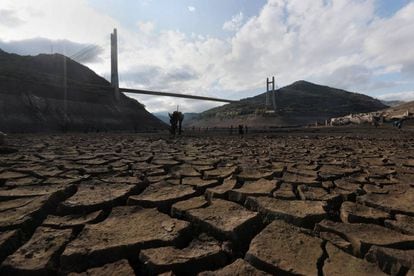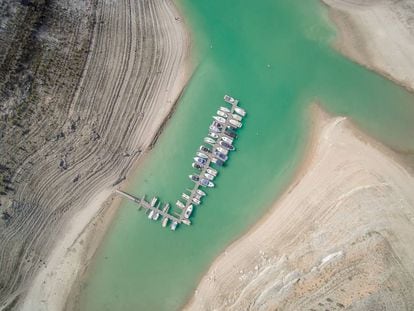After a long, dry summer, Spain’s drought intensifies
Reservoirs are at 43% capacity when they are normally at 60% during this time of the year

“Look, you can see the door as it was,” say Lourdes and Javier, a couple in their twenties, as they take photos among the skeletons of the houses that 60 years ago were once a town in the region of Castilla-Leon in northwestern Spain. They are on vacation and have taken a day trip to the Barrios de Luna reservoir, north of the city of León. “We had seen on social media that it had little water, but we did not expect this. It is spectacular.” Even cars can drive through the dry bed of this marsh, which is at 7% of its capacity. The drought has brought to light a dozen of the ancient villages that were evicted to build the reservoir half a century ago.

At the foot of the retaining wall, in the town of Barrios de Luna, the owner of a bar wonders why there is so much attention about the reservoir; it’s not the first time it has practically dried out. “People are also coming, but some years in October it’s like this too.” That's the problem. This time a year ago, the reservoir had almost six times more water than now, alllowing farmers to irrigate some 35,000 hectares of crops. But not this year: the drought forced a cut in irrigation in August, and there are fears the harvest will be lost, if it hasn’t already been.
2017 is the third driest year of all time, behind 1981 and 2005
The situation in the northwest of Spain stands out, but the drought has attacked the entire country. Reservoirs have lost half their capacity over the long, hot summer, which preceded a dry winter. According to the latest data from the Ministry of Agriculture, Food and Environment, they now stand at 42.9% capacity, with some basins at 17.2% capacity. Water reserves are almost 26% below the average of the last 10 years.
“This year is unheard of. We have been watering crops for 50 years with water from these reservoirs, but nobody has ever known a drought like this,” says Matías Llorente, general secretary of a local farming association. He estimates that at least 30% of spring crops (corn, potatoes, beets, beans), which are irrigated until September 30, will be lost.
The Barrios de Luna reservoir is the worst in the region. The regoinal government has now declared a situation of prolonged drought. In other areas, there has been drought declared since 2015.

The lack of rain explains much of the situation. Cumulative rainfall so far in the hydrological year, which runs from October 1, 2016 to September 30, 2017, is down 12%, according to Ana Casals, a spokeswoman for the State Agency of Meteorology (Aemet). This makes 2017 the third driest year, behind 1981 and 2005.
Up to 37 of 150 districts in Spain were in an “emergency” situation due to water shortages at the end of June, according to the latest data. This is the most serious level of classification.
One of Congress’ first tasks this month will be the adoption of a draft law on urgent measures to mitigate the effects of the drought.
English version by Debora Almeida.












































